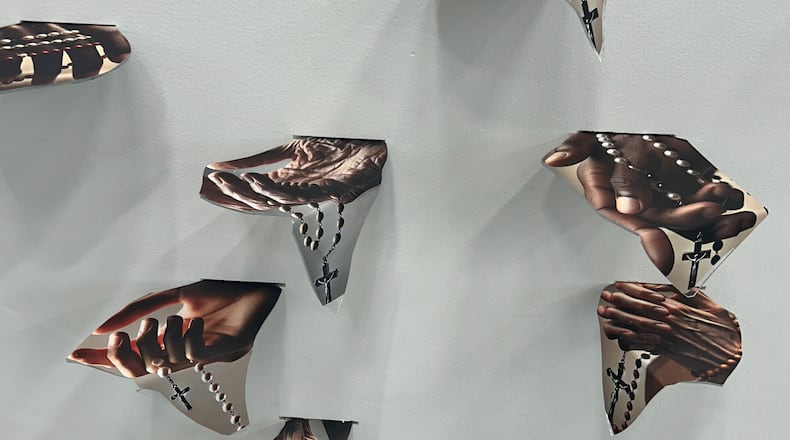What is the backstory of concrete, as a material? It has been around since Roman times, but its use gained new traction in modern architecture and art. Concrete was well loved by Le Corbusier, Frank Lloyd Wright, and Henry Moore. Cities were rebuilt with concrete after World War II, and it was in turn used to construct memorials. British artist Rachel Whiteread’s Judenplatz Holocaust Memorial in Vienna, for example, casts a library in negative space, thereby lending dimensionality to the concept of what is missing.
Symbolically, concrete can represent transformation, as it is created chemically by changing from powder to liquid to a solid form.
Emotionally, there seems to be a connection between the permanence of concrete and the way in which a photograph freezes a moment in time even after the subject is gone.
A distinct memory of Mann’s mother passing from a heart attack found its way into the concrete hands placed on the floor of The Co. “They were trying to save her, and they couldn’t,” he reflects, and describes being invited to see her right after.
On the floor of the hospital room, he noticed latex gloves that had been hastily tossed off by the paramedics.
“As I was making the work, I was wearing (gloves) while making the concrete. And I’m changing them all the time.”
One day while removing gloves he made the connection to the emergency room. With the extra concrete, he filled his gloves.
“They were just this human presence for me that interacts with the work.”
As for glass, it acts in this show like a man-made thorn that keeps you on your toes. ”Last Arrangement” presents a large glass shard sticking out of the side of an acrylic vitrine. Inside the case are the words, “We shall be parted forever”. The piece does seem to suggest, don’t get close. (Sage advice if you should bring a child to this show.)
Credit: Hannah Kasper Levinson
Credit: Hannah Kasper Levinson
As a tribute to his mother, the exhibit is not especially warm and fuzzy. The photographs are literally untouchable; mounted as they are to cut glass, they would cut you if you tried. This “emotion of violence”, says Mann, is inherent to working with glass.
“Penance” depicts photographs of AI-generated hands in various skin tones and phases of life, all holding Catholic rosary prayer beads. The photos are inkjet prints mounted to sharp-edged glass that roughly correspond to the shapes of the hands. The materiality seems to suggest that these are not hands to hold. Rather, they may be a critique of the religion to which they refer: handle with care.
The rosary was the artist’s mother’s favorite element of Catholic ritual.
“For her I think it was that there was a female figure there with power, but for me, the rosary was about punishment.”
Credit: Hannah Kasper Levinson
Credit: Hannah Kasper Levinson
Speaking of thorns, we see nature’s armor echoed over in The Co’s Gallery B with Sean Wilkinson’s exhibit, “Flora.” Wilkinson, a former professor of Mann, has on display a series of tidy inkjet prints depicting close-up shots of branches throughout the seasons.
The hues of the plants evolve from celadon green to gray to umber, moving forward through time subtly like the hands of a clock. Wilkinson’s photo series encircles us, reflecting the hopefulness that comes with the changes of season, from buds to leafing out to bare thorns, and back again.
The collection of images reminds this writer of a recent passage from “Poor Will’s Almanak” by local naturalist Bill Felker: “Little by little, the leaves are coming down, and they’re covering summer when they do that. You’ll be measuring, as well as anyone, the turn of the earth.”
It’ll be warm again before we know it.
Stop by Dayton’s contemporary art center through Dec. 21 to ponder materials, mortality and seasonal timekeeping.
MORE DETAILS
What: Curtis Mann’s “Precious Blood” and Sean Wilkinson’s “Flora”
When: Through Dec. 21
Where: The Contemporary Dayton, 25 W. Fourth St., Dayton
Online: codayton.org
About the Author



